Carbon Disclosure in the Light of Legitimacy Theory
VerifiedAdded on 2023/04/20
|14
|2553
|333
AI Summary
This research study focuses on the usage of legitimacy theory in predicting the response of companies to carbon disclosure in the Australian market. It explores the impact of carbon emissions and the role of legitimacy theory in corporate social and environmental revelations. The literature review section analyzes three different journals on carbon disclosure in the light of legitimacy theory. The conclusion highlights the importance of well-designed corporate reporting with emphasis on carbon disclosure for achieving sustainability.
Contribute Materials
Your contribution can guide someone’s learning journey. Share your
documents today.
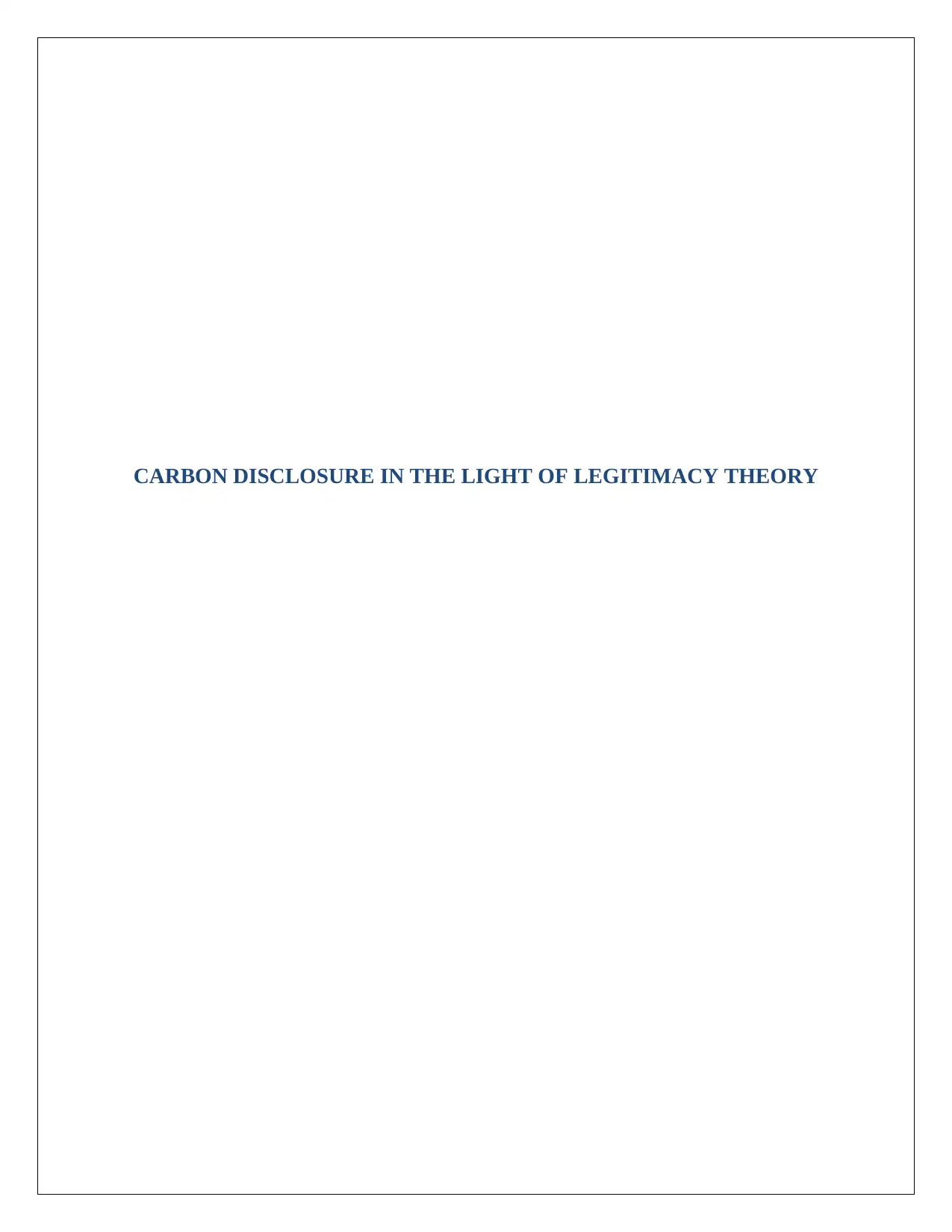
CARBON DISCLOSURE IN THE LIGHT OF LEGITIMACY THEORY
Secure Best Marks with AI Grader
Need help grading? Try our AI Grader for instant feedback on your assignments.
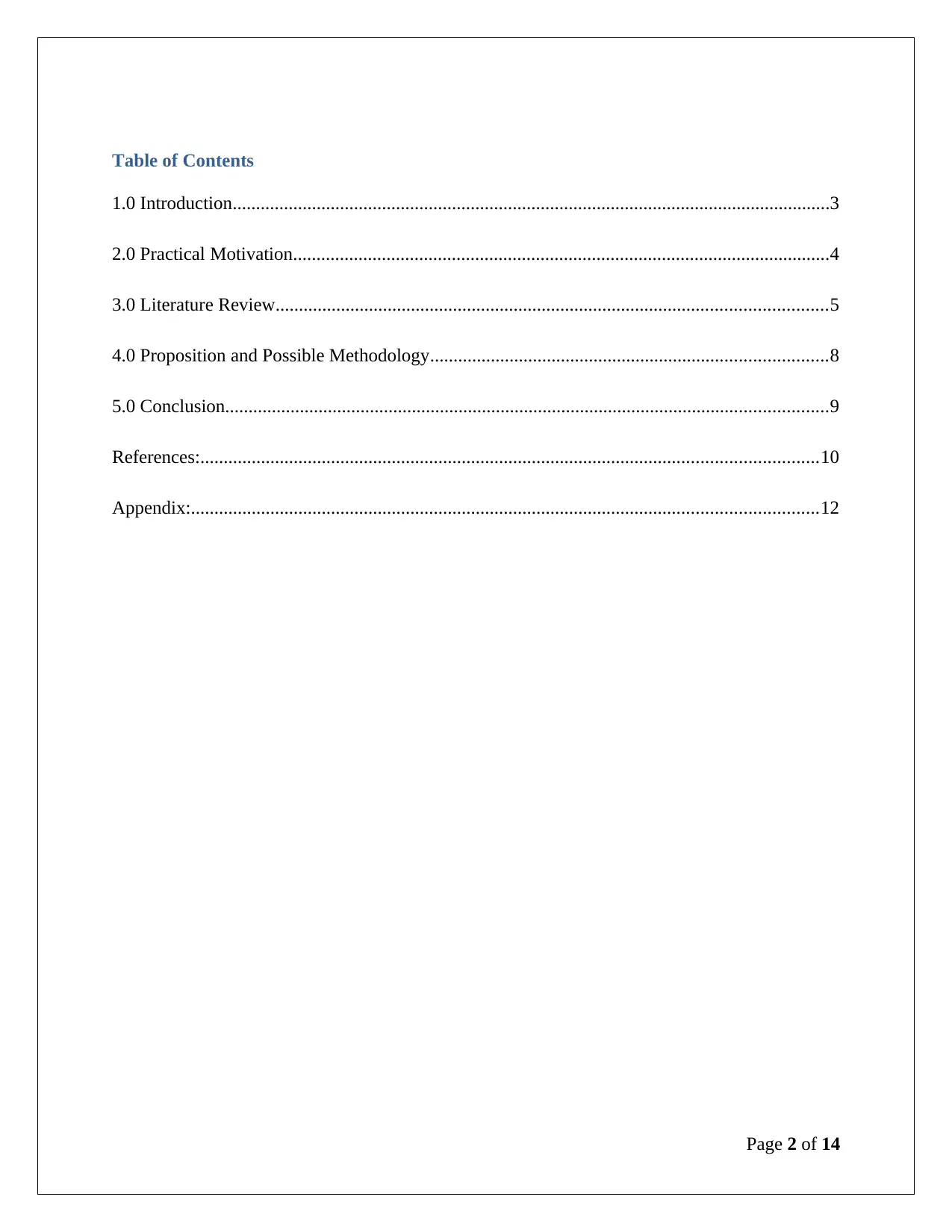
Table of Contents
1.0 Introduction................................................................................................................................3
2.0 Practical Motivation...................................................................................................................4
3.0 Literature Review......................................................................................................................5
4.0 Proposition and Possible Methodology.....................................................................................8
5.0 Conclusion.................................................................................................................................9
References:....................................................................................................................................10
Appendix:......................................................................................................................................12
Page 2 of 14
1.0 Introduction................................................................................................................................3
2.0 Practical Motivation...................................................................................................................4
3.0 Literature Review......................................................................................................................5
4.0 Proposition and Possible Methodology.....................................................................................8
5.0 Conclusion.................................................................................................................................9
References:....................................................................................................................................10
Appendix:......................................................................................................................................12
Page 2 of 14
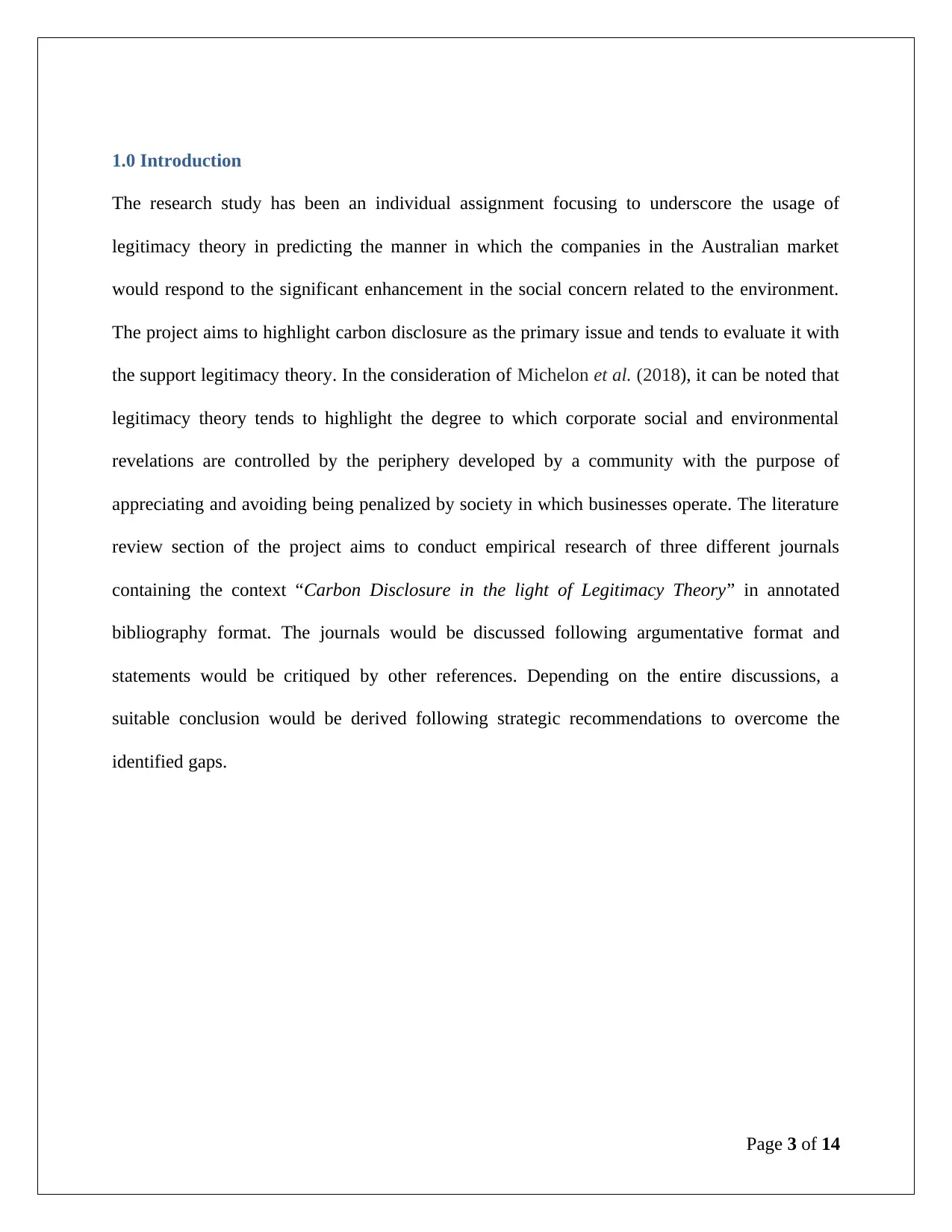
1.0 Introduction
The research study has been an individual assignment focusing to underscore the usage of
legitimacy theory in predicting the manner in which the companies in the Australian market
would respond to the significant enhancement in the social concern related to the environment.
The project aims to highlight carbon disclosure as the primary issue and tends to evaluate it with
the support legitimacy theory. In the consideration of Michelon et al. (2018), it can be noted that
legitimacy theory tends to highlight the degree to which corporate social and environmental
revelations are controlled by the periphery developed by a community with the purpose of
appreciating and avoiding being penalized by society in which businesses operate. The literature
review section of the project aims to conduct empirical research of three different journals
containing the context “Carbon Disclosure in the light of Legitimacy Theory” in annotated
bibliography format. The journals would be discussed following argumentative format and
statements would be critiqued by other references. Depending on the entire discussions, a
suitable conclusion would be derived following strategic recommendations to overcome the
identified gaps.
Page 3 of 14
The research study has been an individual assignment focusing to underscore the usage of
legitimacy theory in predicting the manner in which the companies in the Australian market
would respond to the significant enhancement in the social concern related to the environment.
The project aims to highlight carbon disclosure as the primary issue and tends to evaluate it with
the support legitimacy theory. In the consideration of Michelon et al. (2018), it can be noted that
legitimacy theory tends to highlight the degree to which corporate social and environmental
revelations are controlled by the periphery developed by a community with the purpose of
appreciating and avoiding being penalized by society in which businesses operate. The literature
review section of the project aims to conduct empirical research of three different journals
containing the context “Carbon Disclosure in the light of Legitimacy Theory” in annotated
bibliography format. The journals would be discussed following argumentative format and
statements would be critiqued by other references. Depending on the entire discussions, a
suitable conclusion would be derived following strategic recommendations to overcome the
identified gaps.
Page 3 of 14
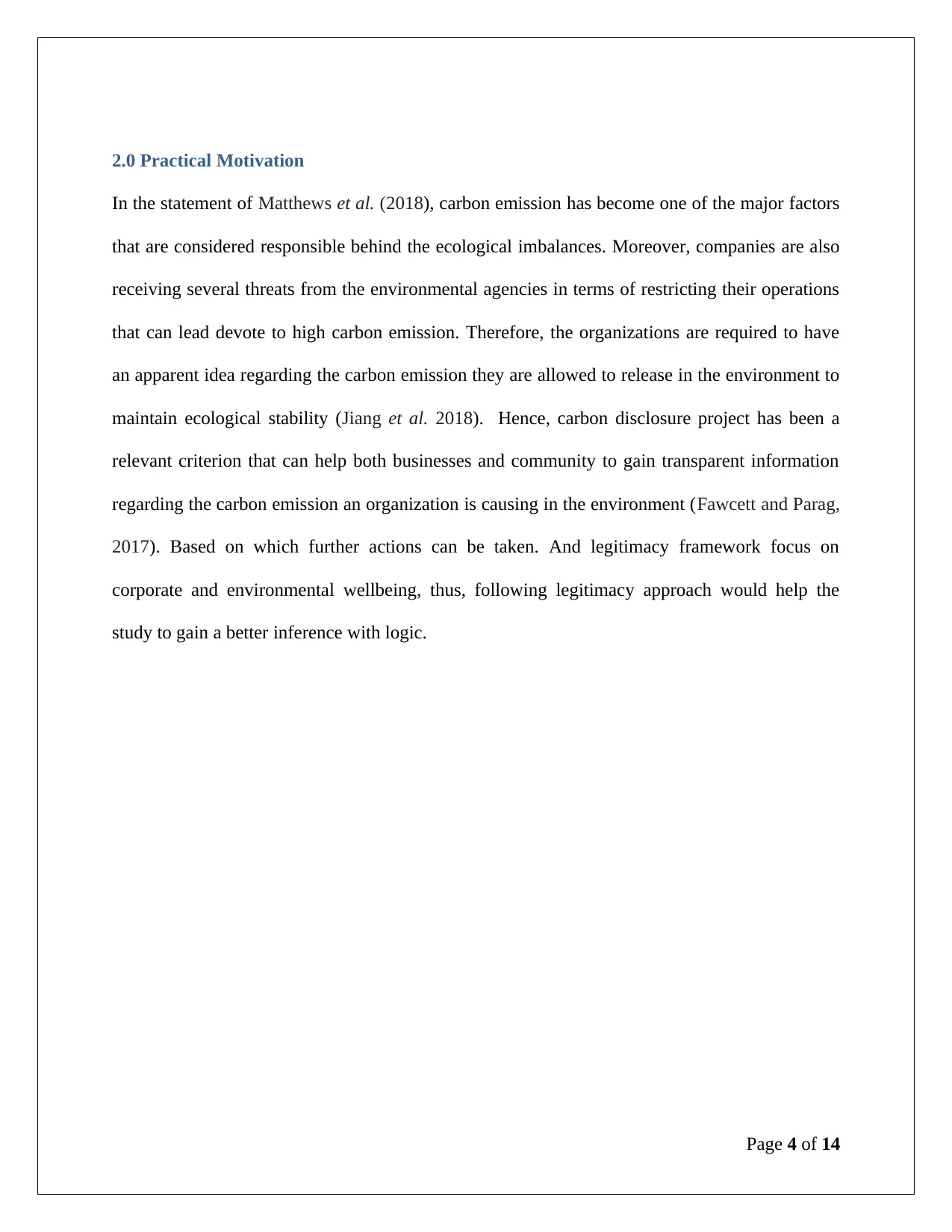
2.0 Practical Motivation
In the statement of Matthews et al. (2018), carbon emission has become one of the major factors
that are considered responsible behind the ecological imbalances. Moreover, companies are also
receiving several threats from the environmental agencies in terms of restricting their operations
that can lead devote to high carbon emission. Therefore, the organizations are required to have
an apparent idea regarding the carbon emission they are allowed to release in the environment to
maintain ecological stability (Jiang et al. 2018). Hence, carbon disclosure project has been a
relevant criterion that can help both businesses and community to gain transparent information
regarding the carbon emission an organization is causing in the environment (Fawcett and Parag,
2017). Based on which further actions can be taken. And legitimacy framework focus on
corporate and environmental wellbeing, thus, following legitimacy approach would help the
study to gain a better inference with logic.
Page 4 of 14
In the statement of Matthews et al. (2018), carbon emission has become one of the major factors
that are considered responsible behind the ecological imbalances. Moreover, companies are also
receiving several threats from the environmental agencies in terms of restricting their operations
that can lead devote to high carbon emission. Therefore, the organizations are required to have
an apparent idea regarding the carbon emission they are allowed to release in the environment to
maintain ecological stability (Jiang et al. 2018). Hence, carbon disclosure project has been a
relevant criterion that can help both businesses and community to gain transparent information
regarding the carbon emission an organization is causing in the environment (Fawcett and Parag,
2017). Based on which further actions can be taken. And legitimacy framework focus on
corporate and environmental wellbeing, thus, following legitimacy approach would help the
study to gain a better inference with logic.
Page 4 of 14
Secure Best Marks with AI Grader
Need help grading? Try our AI Grader for instant feedback on your assignments.
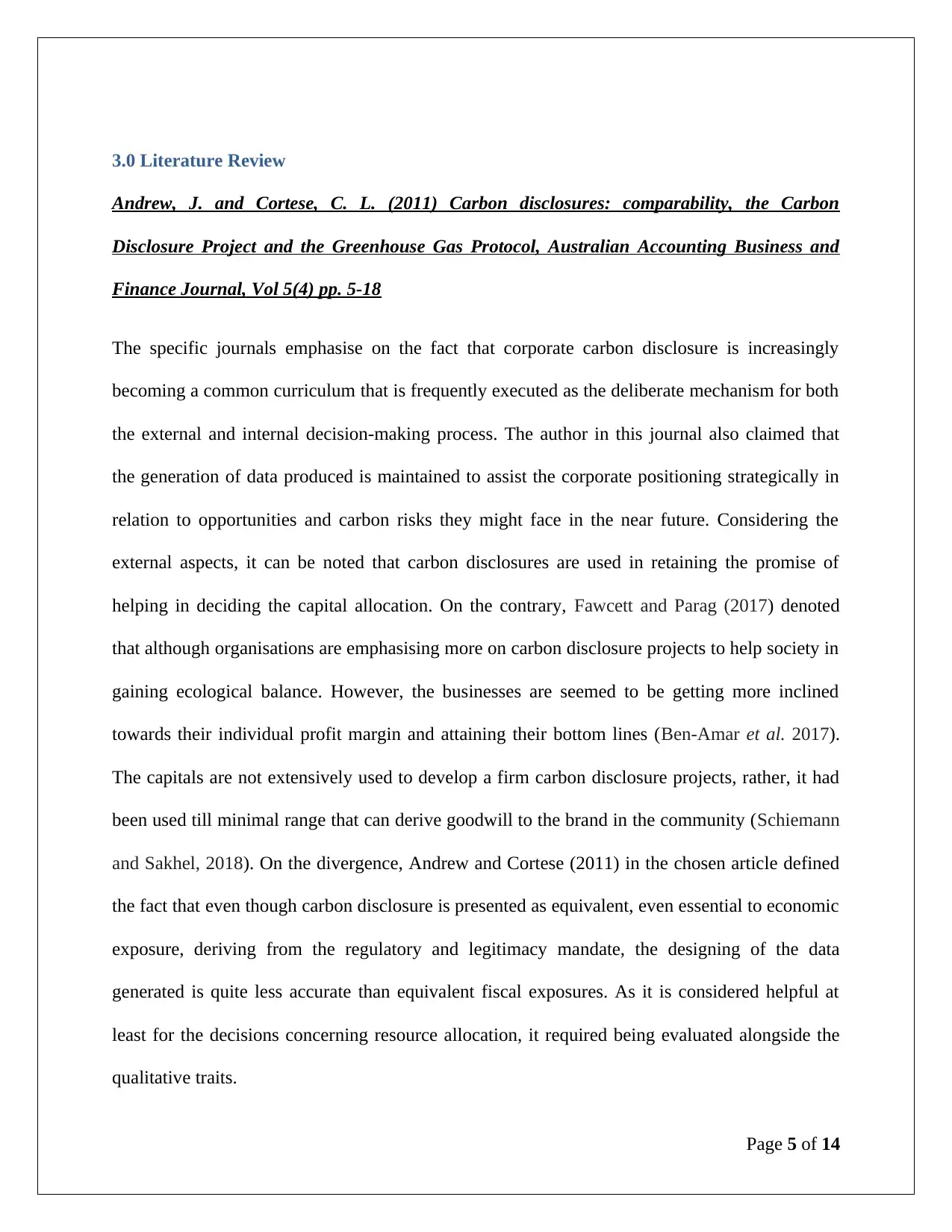
3.0 Literature Review
Andrew, J. and Cortese, C. L. (2011) Carbon disclosures: comparability, the Carbon
Disclosure Project and the Greenhouse Gas Protocol, Australian Accounting Business and
Finance Journal, Vol 5(4) pp. 5-18
The specific journals emphasise on the fact that corporate carbon disclosure is increasingly
becoming a common curriculum that is frequently executed as the deliberate mechanism for both
the external and internal decision-making process. The author in this journal also claimed that
the generation of data produced is maintained to assist the corporate positioning strategically in
relation to opportunities and carbon risks they might face in the near future. Considering the
external aspects, it can be noted that carbon disclosures are used in retaining the promise of
helping in deciding the capital allocation. On the contrary, Fawcett and Parag (2017) denoted
that although organisations are emphasising more on carbon disclosure projects to help society in
gaining ecological balance. However, the businesses are seemed to be getting more inclined
towards their individual profit margin and attaining their bottom lines (Ben-Amar et al. 2017).
The capitals are not extensively used to develop a firm carbon disclosure projects, rather, it had
been used till minimal range that can derive goodwill to the brand in the community (Schiemann
and Sakhel, 2018). On the divergence, Andrew and Cortese (2011) in the chosen article defined
the fact that even though carbon disclosure is presented as equivalent, even essential to economic
exposure, deriving from the regulatory and legitimacy mandate, the designing of the data
generated is quite less accurate than equivalent fiscal exposures. As it is considered helpful at
least for the decisions concerning resource allocation, it required being evaluated alongside the
qualitative traits.
Page 5 of 14
Andrew, J. and Cortese, C. L. (2011) Carbon disclosures: comparability, the Carbon
Disclosure Project and the Greenhouse Gas Protocol, Australian Accounting Business and
Finance Journal, Vol 5(4) pp. 5-18
The specific journals emphasise on the fact that corporate carbon disclosure is increasingly
becoming a common curriculum that is frequently executed as the deliberate mechanism for both
the external and internal decision-making process. The author in this journal also claimed that
the generation of data produced is maintained to assist the corporate positioning strategically in
relation to opportunities and carbon risks they might face in the near future. Considering the
external aspects, it can be noted that carbon disclosures are used in retaining the promise of
helping in deciding the capital allocation. On the contrary, Fawcett and Parag (2017) denoted
that although organisations are emphasising more on carbon disclosure projects to help society in
gaining ecological balance. However, the businesses are seemed to be getting more inclined
towards their individual profit margin and attaining their bottom lines (Ben-Amar et al. 2017).
The capitals are not extensively used to develop a firm carbon disclosure projects, rather, it had
been used till minimal range that can derive goodwill to the brand in the community (Schiemann
and Sakhel, 2018). On the divergence, Andrew and Cortese (2011) in the chosen article defined
the fact that even though carbon disclosure is presented as equivalent, even essential to economic
exposure, deriving from the regulatory and legitimacy mandate, the designing of the data
generated is quite less accurate than equivalent fiscal exposures. As it is considered helpful at
least for the decisions concerning resource allocation, it required being evaluated alongside the
qualitative traits.
Page 5 of 14
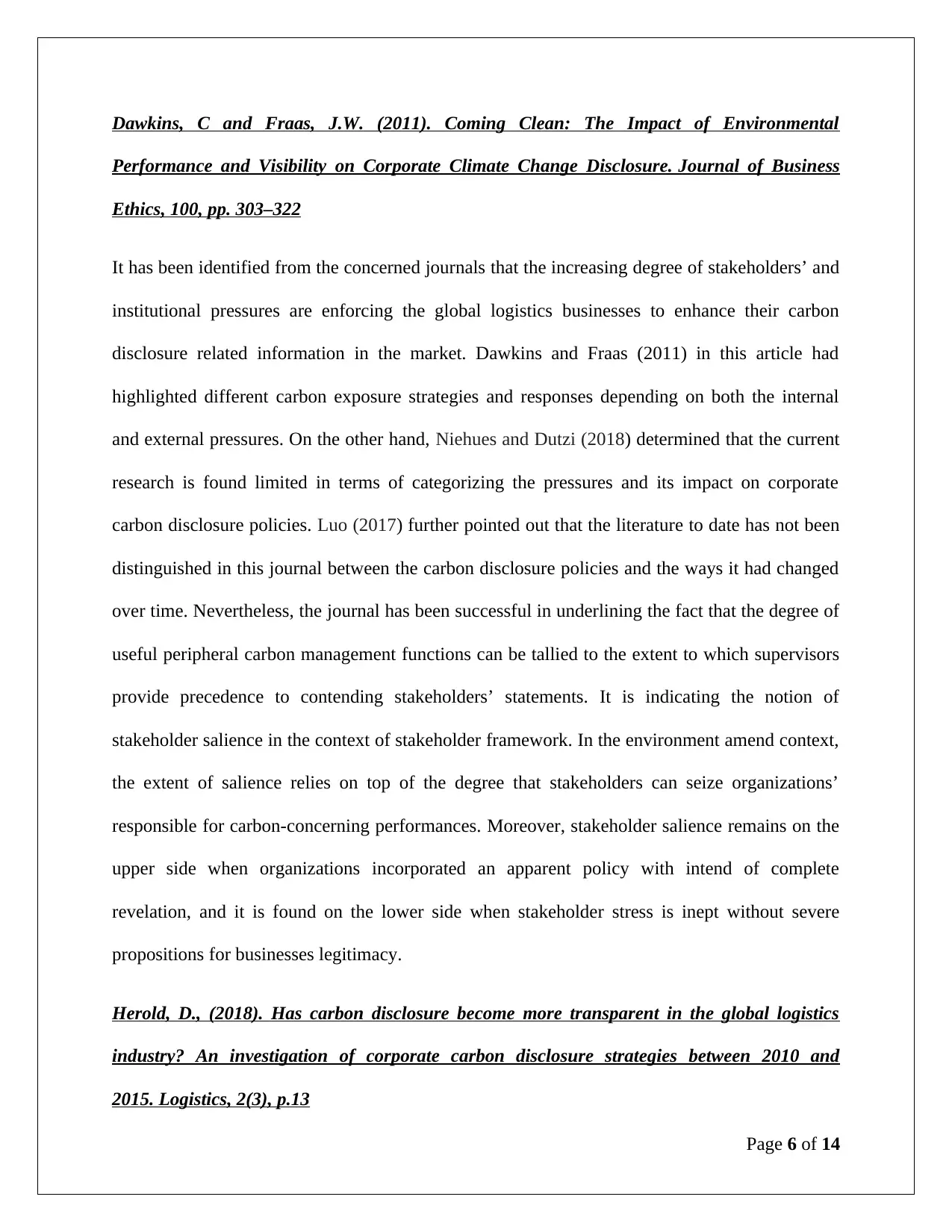
Dawkins, C and Fraas, J.W. (2011). Coming Clean: The Impact of Environmental
Performance and Visibility on Corporate Climate Change Disclosure. Journal of Business
Ethics, 100, pp. 303–322
It has been identified from the concerned journals that the increasing degree of stakeholders’ and
institutional pressures are enforcing the global logistics businesses to enhance their carbon
disclosure related information in the market. Dawkins and Fraas (2011) in this article had
highlighted different carbon exposure strategies and responses depending on both the internal
and external pressures. On the other hand, Niehues and Dutzi (2018) determined that the current
research is found limited in terms of categorizing the pressures and its impact on corporate
carbon disclosure policies. Luo (2017) further pointed out that the literature to date has not been
distinguished in this journal between the carbon disclosure policies and the ways it had changed
over time. Nevertheless, the journal has been successful in underlining the fact that the degree of
useful peripheral carbon management functions can be tallied to the extent to which supervisors
provide precedence to contending stakeholders’ statements. It is indicating the notion of
stakeholder salience in the context of stakeholder framework. In the environment amend context,
the extent of salience relies on top of the degree that stakeholders can seize organizations’
responsible for carbon-concerning performances. Moreover, stakeholder salience remains on the
upper side when organizations incorporated an apparent policy with intend of complete
revelation, and it is found on the lower side when stakeholder stress is inept without severe
propositions for businesses legitimacy.
Herold, D., (2018). Has carbon disclosure become more transparent in the global logistics
industry? An investigation of corporate carbon disclosure strategies between 2010 and
2015. Logistics, 2(3), p.13
Page 6 of 14
Performance and Visibility on Corporate Climate Change Disclosure. Journal of Business
Ethics, 100, pp. 303–322
It has been identified from the concerned journals that the increasing degree of stakeholders’ and
institutional pressures are enforcing the global logistics businesses to enhance their carbon
disclosure related information in the market. Dawkins and Fraas (2011) in this article had
highlighted different carbon exposure strategies and responses depending on both the internal
and external pressures. On the other hand, Niehues and Dutzi (2018) determined that the current
research is found limited in terms of categorizing the pressures and its impact on corporate
carbon disclosure policies. Luo (2017) further pointed out that the literature to date has not been
distinguished in this journal between the carbon disclosure policies and the ways it had changed
over time. Nevertheless, the journal has been successful in underlining the fact that the degree of
useful peripheral carbon management functions can be tallied to the extent to which supervisors
provide precedence to contending stakeholders’ statements. It is indicating the notion of
stakeholder salience in the context of stakeholder framework. In the environment amend context,
the extent of salience relies on top of the degree that stakeholders can seize organizations’
responsible for carbon-concerning performances. Moreover, stakeholder salience remains on the
upper side when organizations incorporated an apparent policy with intend of complete
revelation, and it is found on the lower side when stakeholder stress is inept without severe
propositions for businesses legitimacy.
Herold, D., (2018). Has carbon disclosure become more transparent in the global logistics
industry? An investigation of corporate carbon disclosure strategies between 2010 and
2015. Logistics, 2(3), p.13
Page 6 of 14
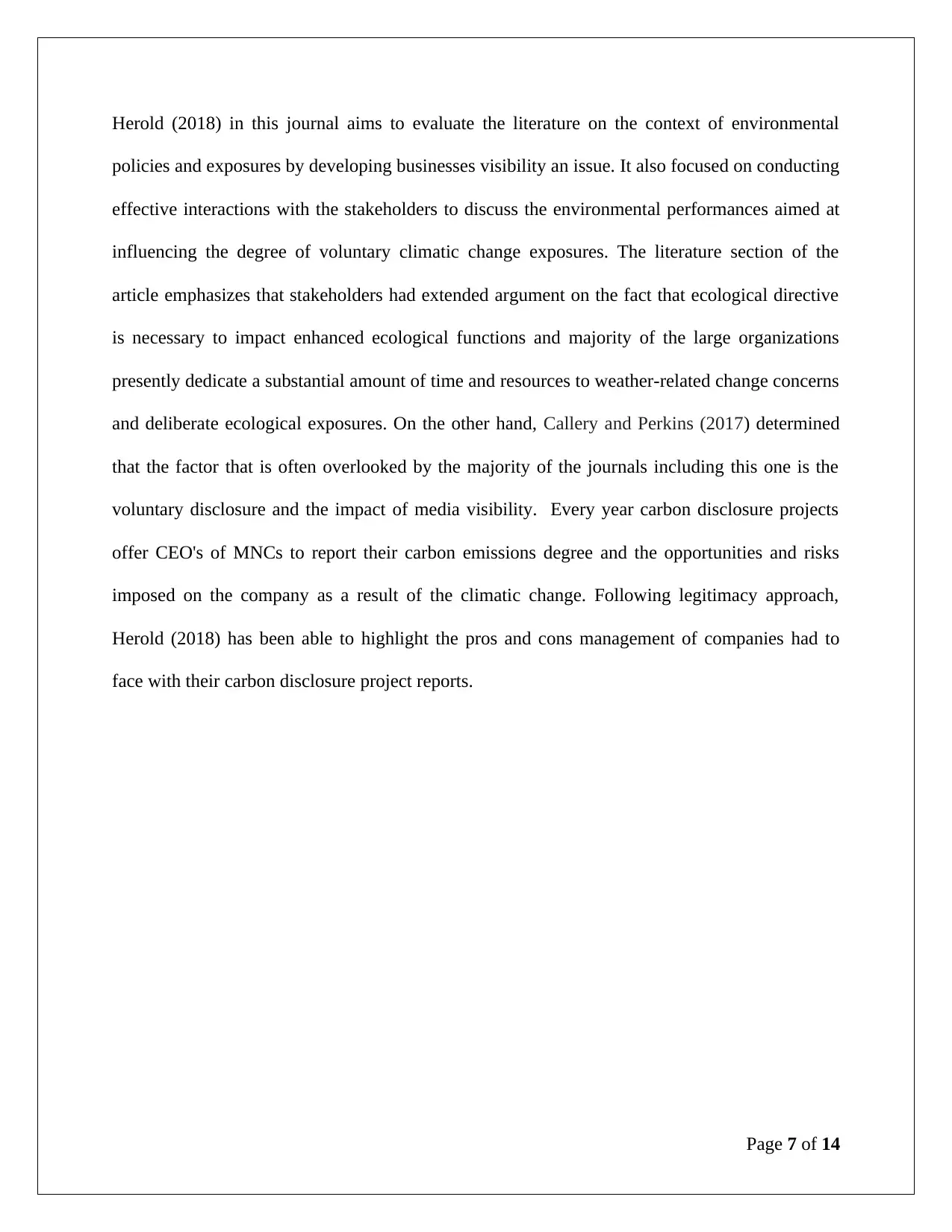
Herold (2018) in this journal aims to evaluate the literature on the context of environmental
policies and exposures by developing businesses visibility an issue. It also focused on conducting
effective interactions with the stakeholders to discuss the environmental performances aimed at
influencing the degree of voluntary climatic change exposures. The literature section of the
article emphasizes that stakeholders had extended argument on the fact that ecological directive
is necessary to impact enhanced ecological functions and majority of the large organizations
presently dedicate a substantial amount of time and resources to weather-related change concerns
and deliberate ecological exposures. On the other hand, Callery and Perkins (2017) determined
that the factor that is often overlooked by the majority of the journals including this one is the
voluntary disclosure and the impact of media visibility. Every year carbon disclosure projects
offer CEO's of MNCs to report their carbon emissions degree and the opportunities and risks
imposed on the company as a result of the climatic change. Following legitimacy approach,
Herold (2018) has been able to highlight the pros and cons management of companies had to
face with their carbon disclosure project reports.
Page 7 of 14
policies and exposures by developing businesses visibility an issue. It also focused on conducting
effective interactions with the stakeholders to discuss the environmental performances aimed at
influencing the degree of voluntary climatic change exposures. The literature section of the
article emphasizes that stakeholders had extended argument on the fact that ecological directive
is necessary to impact enhanced ecological functions and majority of the large organizations
presently dedicate a substantial amount of time and resources to weather-related change concerns
and deliberate ecological exposures. On the other hand, Callery and Perkins (2017) determined
that the factor that is often overlooked by the majority of the journals including this one is the
voluntary disclosure and the impact of media visibility. Every year carbon disclosure projects
offer CEO's of MNCs to report their carbon emissions degree and the opportunities and risks
imposed on the company as a result of the climatic change. Following legitimacy approach,
Herold (2018) has been able to highlight the pros and cons management of companies had to
face with their carbon disclosure project reports.
Page 7 of 14
Paraphrase This Document
Need a fresh take? Get an instant paraphrase of this document with our AI Paraphraser
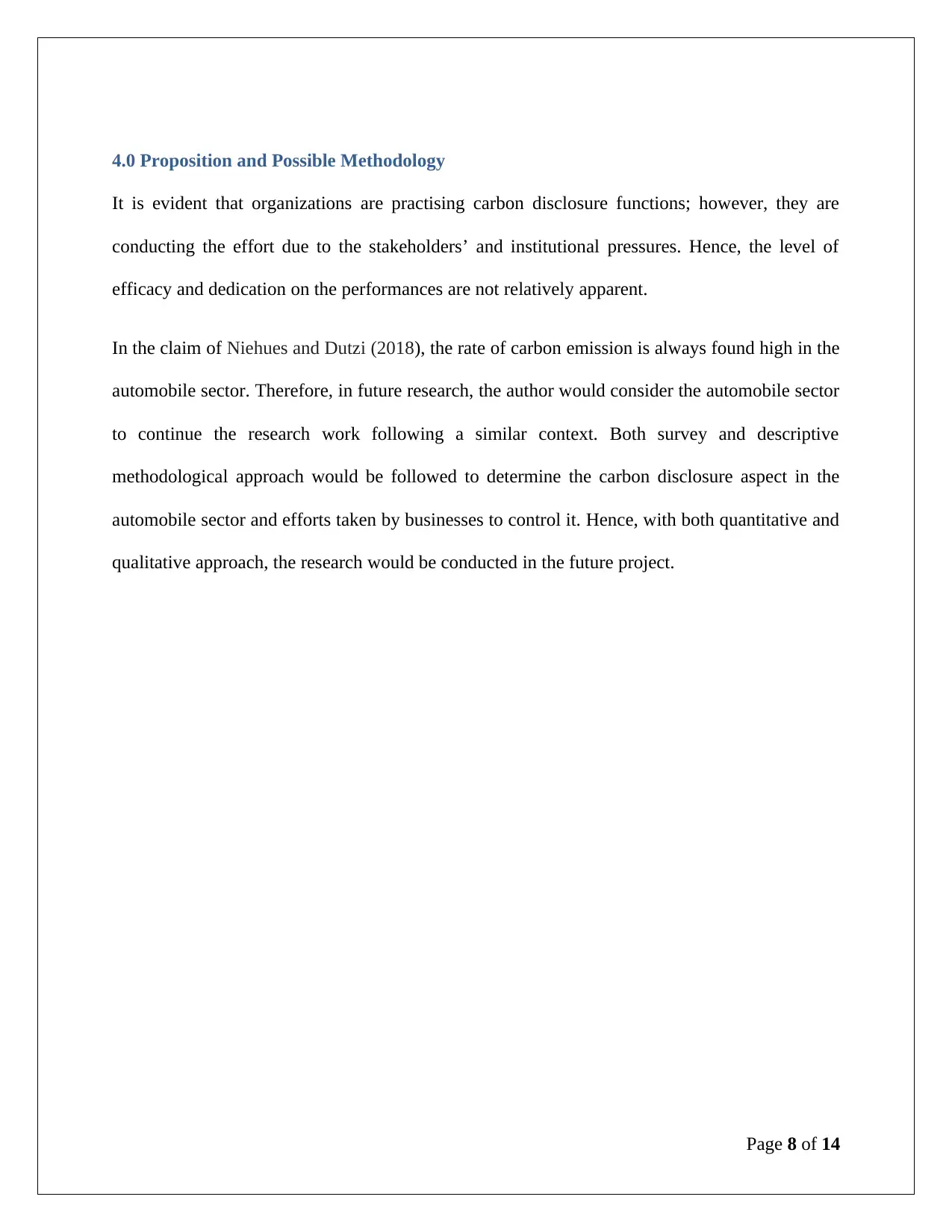
4.0 Proposition and Possible Methodology
It is evident that organizations are practising carbon disclosure functions; however, they are
conducting the effort due to the stakeholders’ and institutional pressures. Hence, the level of
efficacy and dedication on the performances are not relatively apparent.
In the claim of Niehues and Dutzi (2018), the rate of carbon emission is always found high in the
automobile sector. Therefore, in future research, the author would consider the automobile sector
to continue the research work following a similar context. Both survey and descriptive
methodological approach would be followed to determine the carbon disclosure aspect in the
automobile sector and efforts taken by businesses to control it. Hence, with both quantitative and
qualitative approach, the research would be conducted in the future project.
Page 8 of 14
It is evident that organizations are practising carbon disclosure functions; however, they are
conducting the effort due to the stakeholders’ and institutional pressures. Hence, the level of
efficacy and dedication on the performances are not relatively apparent.
In the claim of Niehues and Dutzi (2018), the rate of carbon emission is always found high in the
automobile sector. Therefore, in future research, the author would consider the automobile sector
to continue the research work following a similar context. Both survey and descriptive
methodological approach would be followed to determine the carbon disclosure aspect in the
automobile sector and efforts taken by businesses to control it. Hence, with both quantitative and
qualitative approach, the research would be conducted in the future project.
Page 8 of 14
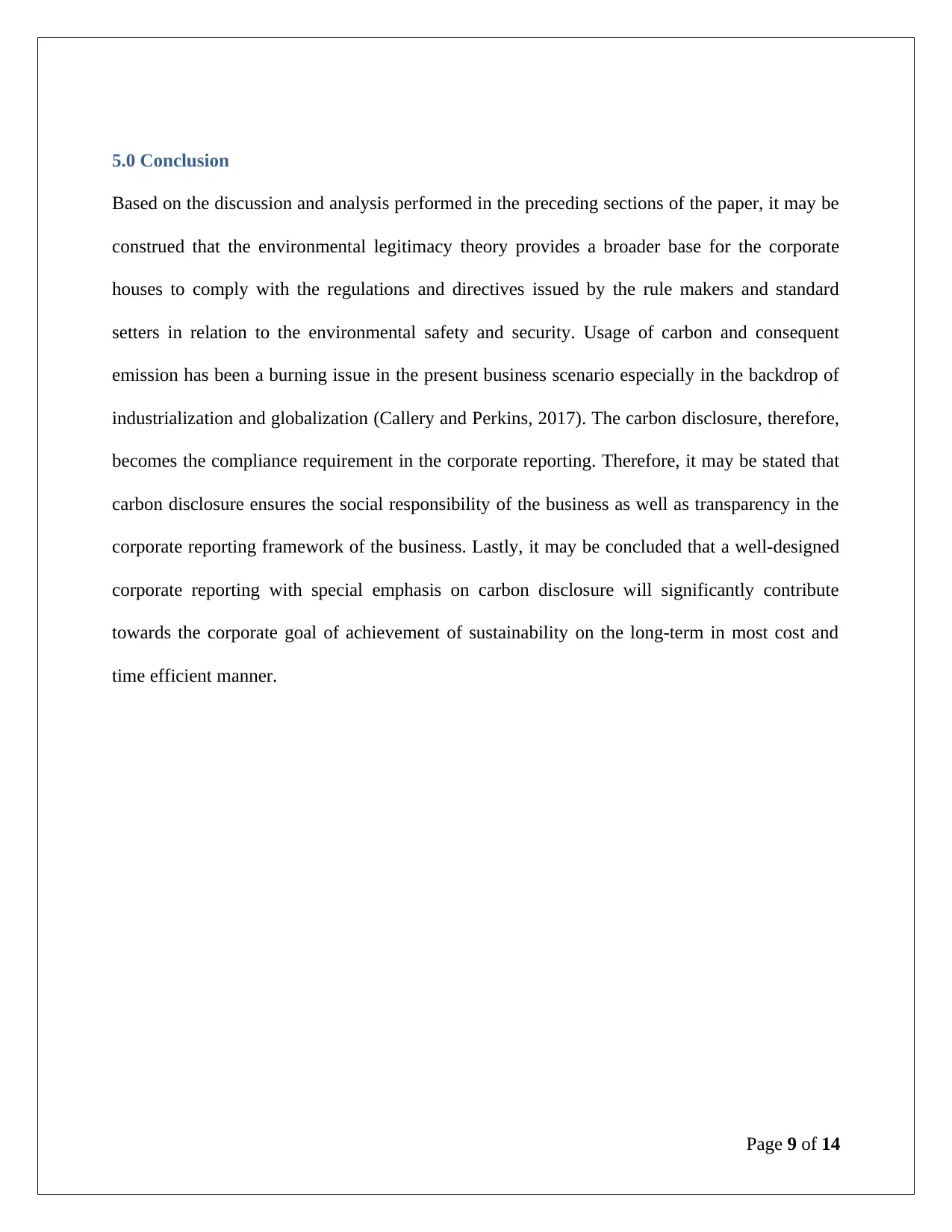
5.0 Conclusion
Based on the discussion and analysis performed in the preceding sections of the paper, it may be
construed that the environmental legitimacy theory provides a broader base for the corporate
houses to comply with the regulations and directives issued by the rule makers and standard
setters in relation to the environmental safety and security. Usage of carbon and consequent
emission has been a burning issue in the present business scenario especially in the backdrop of
industrialization and globalization (Callery and Perkins, 2017). The carbon disclosure, therefore,
becomes the compliance requirement in the corporate reporting. Therefore, it may be stated that
carbon disclosure ensures the social responsibility of the business as well as transparency in the
corporate reporting framework of the business. Lastly, it may be concluded that a well-designed
corporate reporting with special emphasis on carbon disclosure will significantly contribute
towards the corporate goal of achievement of sustainability on the long-term in most cost and
time efficient manner.
Page 9 of 14
Based on the discussion and analysis performed in the preceding sections of the paper, it may be
construed that the environmental legitimacy theory provides a broader base for the corporate
houses to comply with the regulations and directives issued by the rule makers and standard
setters in relation to the environmental safety and security. Usage of carbon and consequent
emission has been a burning issue in the present business scenario especially in the backdrop of
industrialization and globalization (Callery and Perkins, 2017). The carbon disclosure, therefore,
becomes the compliance requirement in the corporate reporting. Therefore, it may be stated that
carbon disclosure ensures the social responsibility of the business as well as transparency in the
corporate reporting framework of the business. Lastly, it may be concluded that a well-designed
corporate reporting with special emphasis on carbon disclosure will significantly contribute
towards the corporate goal of achievement of sustainability on the long-term in most cost and
time efficient manner.
Page 9 of 14
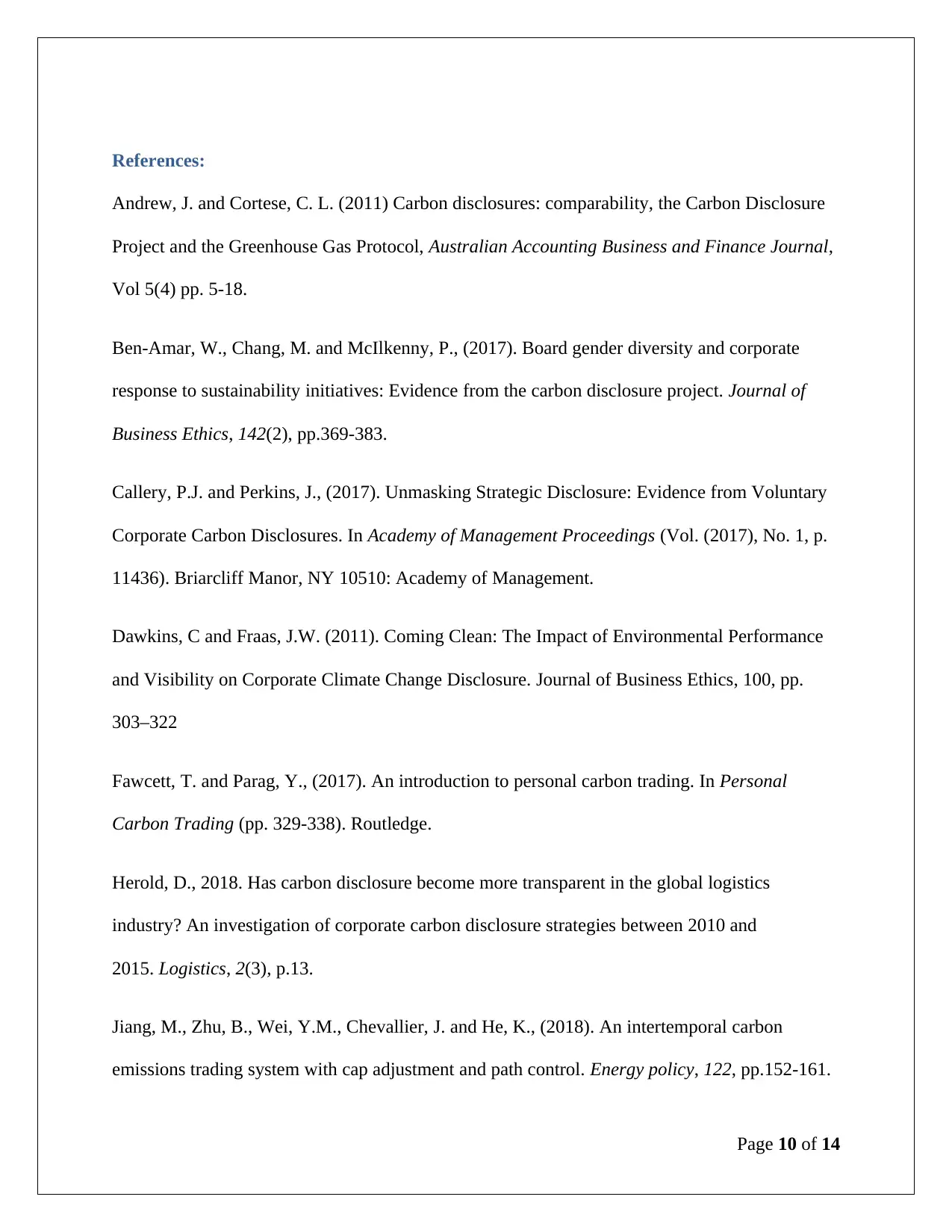
References:
Andrew, J. and Cortese, C. L. (2011) Carbon disclosures: comparability, the Carbon Disclosure
Project and the Greenhouse Gas Protocol, Australian Accounting Business and Finance Journal,
Vol 5(4) pp. 5-18.
Ben-Amar, W., Chang, M. and McIlkenny, P., (2017). Board gender diversity and corporate
response to sustainability initiatives: Evidence from the carbon disclosure project. Journal of
Business Ethics, 142(2), pp.369-383.
Callery, P.J. and Perkins, J., (2017). Unmasking Strategic Disclosure: Evidence from Voluntary
Corporate Carbon Disclosures. In Academy of Management Proceedings (Vol. (2017), No. 1, p.
11436). Briarcliff Manor, NY 10510: Academy of Management.
Dawkins, C and Fraas, J.W. (2011). Coming Clean: The Impact of Environmental Performance
and Visibility on Corporate Climate Change Disclosure. Journal of Business Ethics, 100, pp.
303–322
Fawcett, T. and Parag, Y., (2017). An introduction to personal carbon trading. In Personal
Carbon Trading (pp. 329-338). Routledge.
Herold, D., 2018. Has carbon disclosure become more transparent in the global logistics
industry? An investigation of corporate carbon disclosure strategies between 2010 and
2015. Logistics, 2(3), p.13.
Jiang, M., Zhu, B., Wei, Y.M., Chevallier, J. and He, K., (2018). An intertemporal carbon
emissions trading system with cap adjustment and path control. Energy policy, 122, pp.152-161.
Page 10 of 14
Andrew, J. and Cortese, C. L. (2011) Carbon disclosures: comparability, the Carbon Disclosure
Project and the Greenhouse Gas Protocol, Australian Accounting Business and Finance Journal,
Vol 5(4) pp. 5-18.
Ben-Amar, W., Chang, M. and McIlkenny, P., (2017). Board gender diversity and corporate
response to sustainability initiatives: Evidence from the carbon disclosure project. Journal of
Business Ethics, 142(2), pp.369-383.
Callery, P.J. and Perkins, J., (2017). Unmasking Strategic Disclosure: Evidence from Voluntary
Corporate Carbon Disclosures. In Academy of Management Proceedings (Vol. (2017), No. 1, p.
11436). Briarcliff Manor, NY 10510: Academy of Management.
Dawkins, C and Fraas, J.W. (2011). Coming Clean: The Impact of Environmental Performance
and Visibility on Corporate Climate Change Disclosure. Journal of Business Ethics, 100, pp.
303–322
Fawcett, T. and Parag, Y., (2017). An introduction to personal carbon trading. In Personal
Carbon Trading (pp. 329-338). Routledge.
Herold, D., 2018. Has carbon disclosure become more transparent in the global logistics
industry? An investigation of corporate carbon disclosure strategies between 2010 and
2015. Logistics, 2(3), p.13.
Jiang, M., Zhu, B., Wei, Y.M., Chevallier, J. and He, K., (2018). An intertemporal carbon
emissions trading system with cap adjustment and path control. Energy policy, 122, pp.152-161.
Page 10 of 14
Secure Best Marks with AI Grader
Need help grading? Try our AI Grader for instant feedback on your assignments.
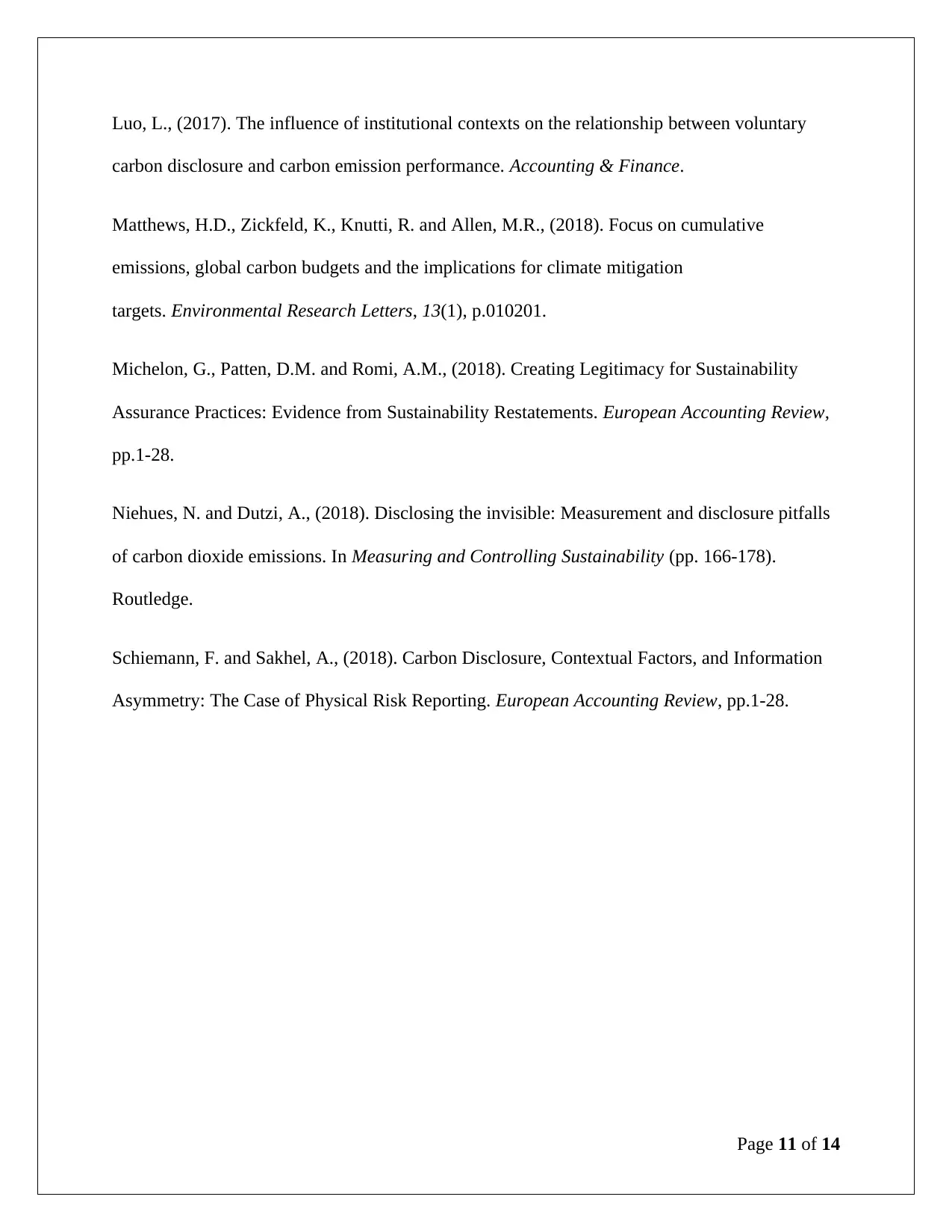
Luo, L., (2017). The influence of institutional contexts on the relationship between voluntary
carbon disclosure and carbon emission performance. Accounting & Finance.
Matthews, H.D., Zickfeld, K., Knutti, R. and Allen, M.R., (2018). Focus on cumulative
emissions, global carbon budgets and the implications for climate mitigation
targets. Environmental Research Letters, 13(1), p.010201.
Michelon, G., Patten, D.M. and Romi, A.M., (2018). Creating Legitimacy for Sustainability
Assurance Practices: Evidence from Sustainability Restatements. European Accounting Review,
pp.1-28.
Niehues, N. and Dutzi, A., (2018). Disclosing the invisible: Measurement and disclosure pitfalls
of carbon dioxide emissions. In Measuring and Controlling Sustainability (pp. 166-178).
Routledge.
Schiemann, F. and Sakhel, A., (2018). Carbon Disclosure, Contextual Factors, and Information
Asymmetry: The Case of Physical Risk Reporting. European Accounting Review, pp.1-28.
Page 11 of 14
carbon disclosure and carbon emission performance. Accounting & Finance.
Matthews, H.D., Zickfeld, K., Knutti, R. and Allen, M.R., (2018). Focus on cumulative
emissions, global carbon budgets and the implications for climate mitigation
targets. Environmental Research Letters, 13(1), p.010201.
Michelon, G., Patten, D.M. and Romi, A.M., (2018). Creating Legitimacy for Sustainability
Assurance Practices: Evidence from Sustainability Restatements. European Accounting Review,
pp.1-28.
Niehues, N. and Dutzi, A., (2018). Disclosing the invisible: Measurement and disclosure pitfalls
of carbon dioxide emissions. In Measuring and Controlling Sustainability (pp. 166-178).
Routledge.
Schiemann, F. and Sakhel, A., (2018). Carbon Disclosure, Contextual Factors, and Information
Asymmetry: The Case of Physical Risk Reporting. European Accounting Review, pp.1-28.
Page 11 of 14
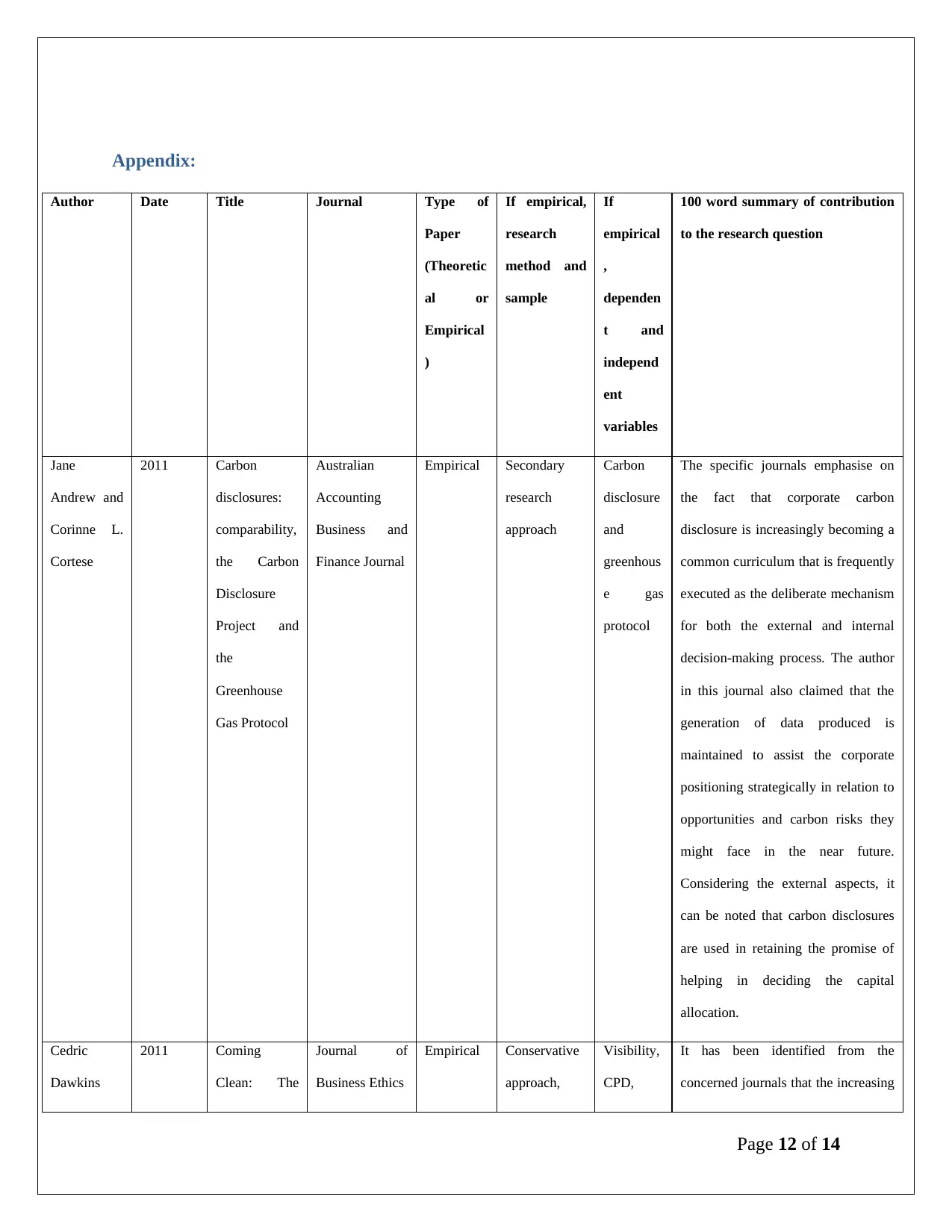
Appendix:
Author Date Title Journal Type of
Paper
(Theoretic
al or
Empirical
)
If empirical,
research
method and
sample
If
empirical
,
dependen
t and
independ
ent
variables
100 word summary of contribution
to the research question
Jane
Andrew and
Corinne L.
Cortese
2011 Carbon
disclosures:
comparability,
the Carbon
Disclosure
Project and
the
Greenhouse
Gas Protocol
Australian
Accounting
Business and
Finance Journal
Empirical Secondary
research
approach
Carbon
disclosure
and
greenhous
e gas
protocol
The specific journals emphasise on
the fact that corporate carbon
disclosure is increasingly becoming a
common curriculum that is frequently
executed as the deliberate mechanism
for both the external and internal
decision-making process. The author
in this journal also claimed that the
generation of data produced is
maintained to assist the corporate
positioning strategically in relation to
opportunities and carbon risks they
might face in the near future.
Considering the external aspects, it
can be noted that carbon disclosures
are used in retaining the promise of
helping in deciding the capital
allocation.
Cedric
Dawkins
2011 Coming
Clean: The
Journal of
Business Ethics
Empirical Conservative
approach,
Visibility,
CPD,
It has been identified from the
concerned journals that the increasing
Page 12 of 14
Author Date Title Journal Type of
Paper
(Theoretic
al or
Empirical
)
If empirical,
research
method and
sample
If
empirical
,
dependen
t and
independ
ent
variables
100 word summary of contribution
to the research question
Jane
Andrew and
Corinne L.
Cortese
2011 Carbon
disclosures:
comparability,
the Carbon
Disclosure
Project and
the
Greenhouse
Gas Protocol
Australian
Accounting
Business and
Finance Journal
Empirical Secondary
research
approach
Carbon
disclosure
and
greenhous
e gas
protocol
The specific journals emphasise on
the fact that corporate carbon
disclosure is increasingly becoming a
common curriculum that is frequently
executed as the deliberate mechanism
for both the external and internal
decision-making process. The author
in this journal also claimed that the
generation of data produced is
maintained to assist the corporate
positioning strategically in relation to
opportunities and carbon risks they
might face in the near future.
Considering the external aspects, it
can be noted that carbon disclosures
are used in retaining the promise of
helping in deciding the capital
allocation.
Cedric
Dawkins
2011 Coming
Clean: The
Journal of
Business Ethics
Empirical Conservative
approach,
Visibility,
CPD,
It has been identified from the
concerned journals that the increasing
Page 12 of 14
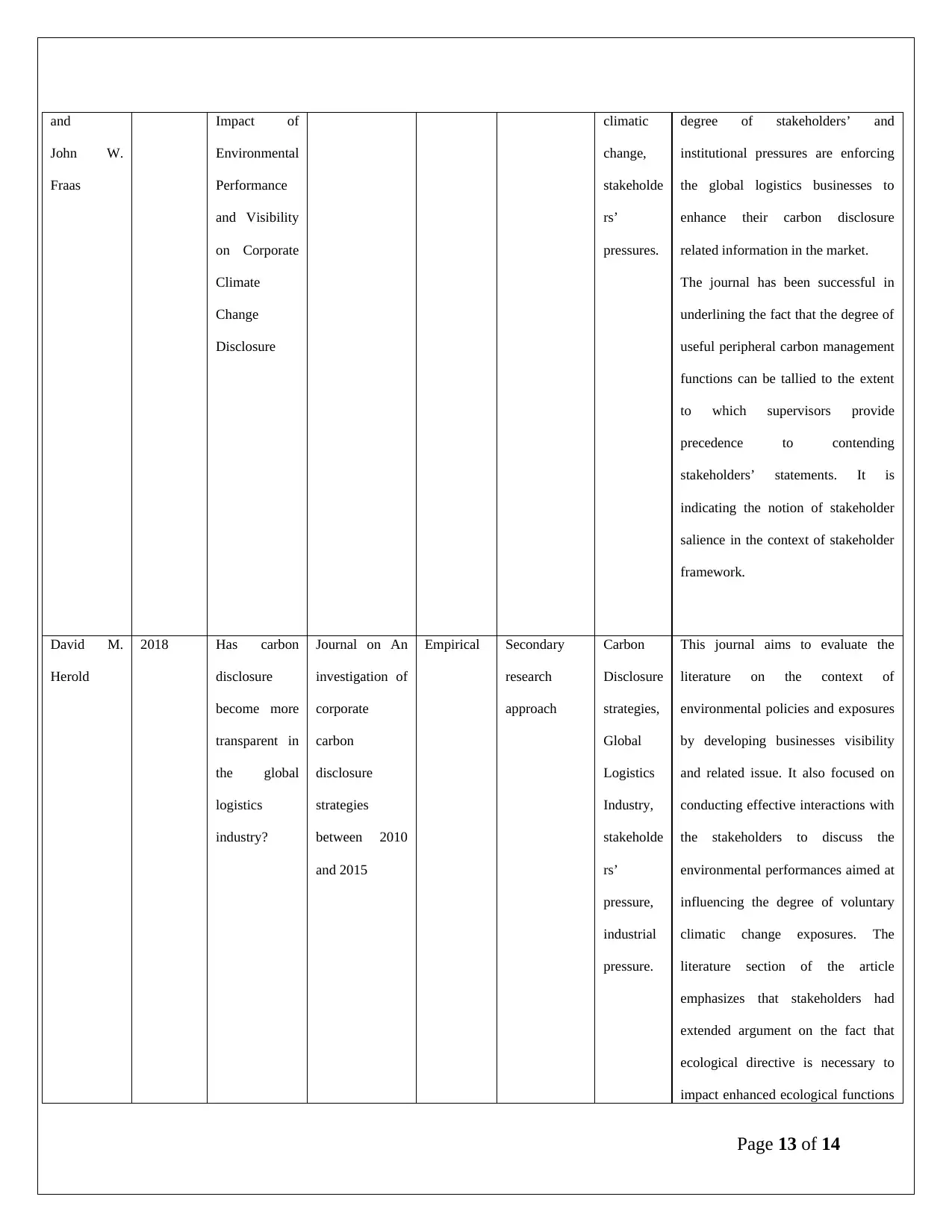
and
John W.
Fraas
Impact of
Environmental
Performance
and Visibility
on Corporate
Climate
Change
Disclosure
climatic
change,
stakeholde
rs’
pressures.
degree of stakeholders’ and
institutional pressures are enforcing
the global logistics businesses to
enhance their carbon disclosure
related information in the market.
The journal has been successful in
underlining the fact that the degree of
useful peripheral carbon management
functions can be tallied to the extent
to which supervisors provide
precedence to contending
stakeholders’ statements. It is
indicating the notion of stakeholder
salience in the context of stakeholder
framework.
David M.
Herold
2018 Has carbon
disclosure
become more
transparent in
the global
logistics
industry?
Journal on An
investigation of
corporate
carbon
disclosure
strategies
between 2010
and 2015
Empirical Secondary
research
approach
Carbon
Disclosure
strategies,
Global
Logistics
Industry,
stakeholde
rs’
pressure,
industrial
pressure.
This journal aims to evaluate the
literature on the context of
environmental policies and exposures
by developing businesses visibility
and related issue. It also focused on
conducting effective interactions with
the stakeholders to discuss the
environmental performances aimed at
influencing the degree of voluntary
climatic change exposures. The
literature section of the article
emphasizes that stakeholders had
extended argument on the fact that
ecological directive is necessary to
impact enhanced ecological functions
Page 13 of 14
John W.
Fraas
Impact of
Environmental
Performance
and Visibility
on Corporate
Climate
Change
Disclosure
climatic
change,
stakeholde
rs’
pressures.
degree of stakeholders’ and
institutional pressures are enforcing
the global logistics businesses to
enhance their carbon disclosure
related information in the market.
The journal has been successful in
underlining the fact that the degree of
useful peripheral carbon management
functions can be tallied to the extent
to which supervisors provide
precedence to contending
stakeholders’ statements. It is
indicating the notion of stakeholder
salience in the context of stakeholder
framework.
David M.
Herold
2018 Has carbon
disclosure
become more
transparent in
the global
logistics
industry?
Journal on An
investigation of
corporate
carbon
disclosure
strategies
between 2010
and 2015
Empirical Secondary
research
approach
Carbon
Disclosure
strategies,
Global
Logistics
Industry,
stakeholde
rs’
pressure,
industrial
pressure.
This journal aims to evaluate the
literature on the context of
environmental policies and exposures
by developing businesses visibility
and related issue. It also focused on
conducting effective interactions with
the stakeholders to discuss the
environmental performances aimed at
influencing the degree of voluntary
climatic change exposures. The
literature section of the article
emphasizes that stakeholders had
extended argument on the fact that
ecological directive is necessary to
impact enhanced ecological functions
Page 13 of 14
Paraphrase This Document
Need a fresh take? Get an instant paraphrase of this document with our AI Paraphraser
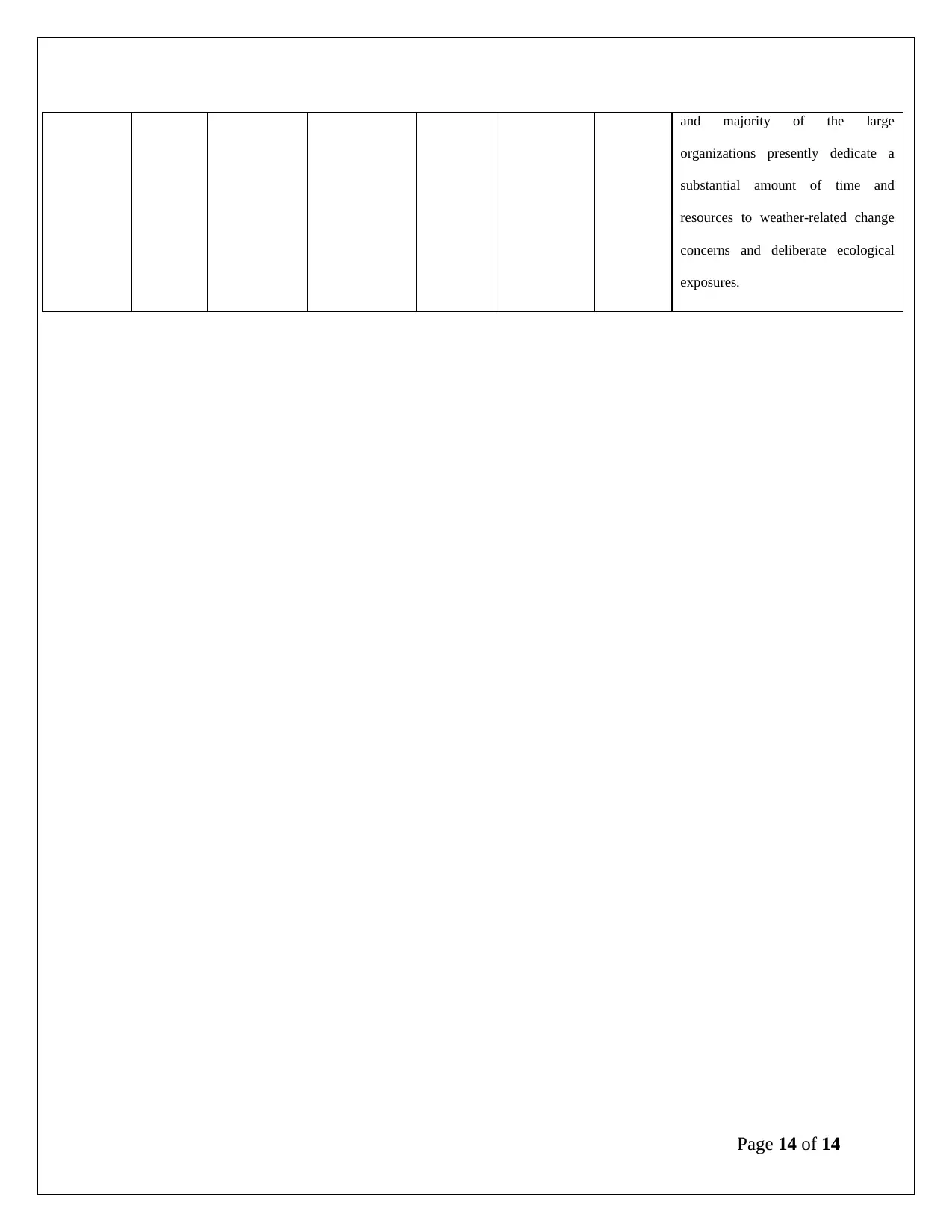
and majority of the large
organizations presently dedicate a
substantial amount of time and
resources to weather-related change
concerns and deliberate ecological
exposures.
Page 14 of 14
organizations presently dedicate a
substantial amount of time and
resources to weather-related change
concerns and deliberate ecological
exposures.
Page 14 of 14
1 out of 14
Your All-in-One AI-Powered Toolkit for Academic Success.
+13062052269
info@desklib.com
Available 24*7 on WhatsApp / Email
![[object Object]](/_next/static/media/star-bottom.7253800d.svg)
Unlock your academic potential
© 2024 | Zucol Services PVT LTD | All rights reserved.





